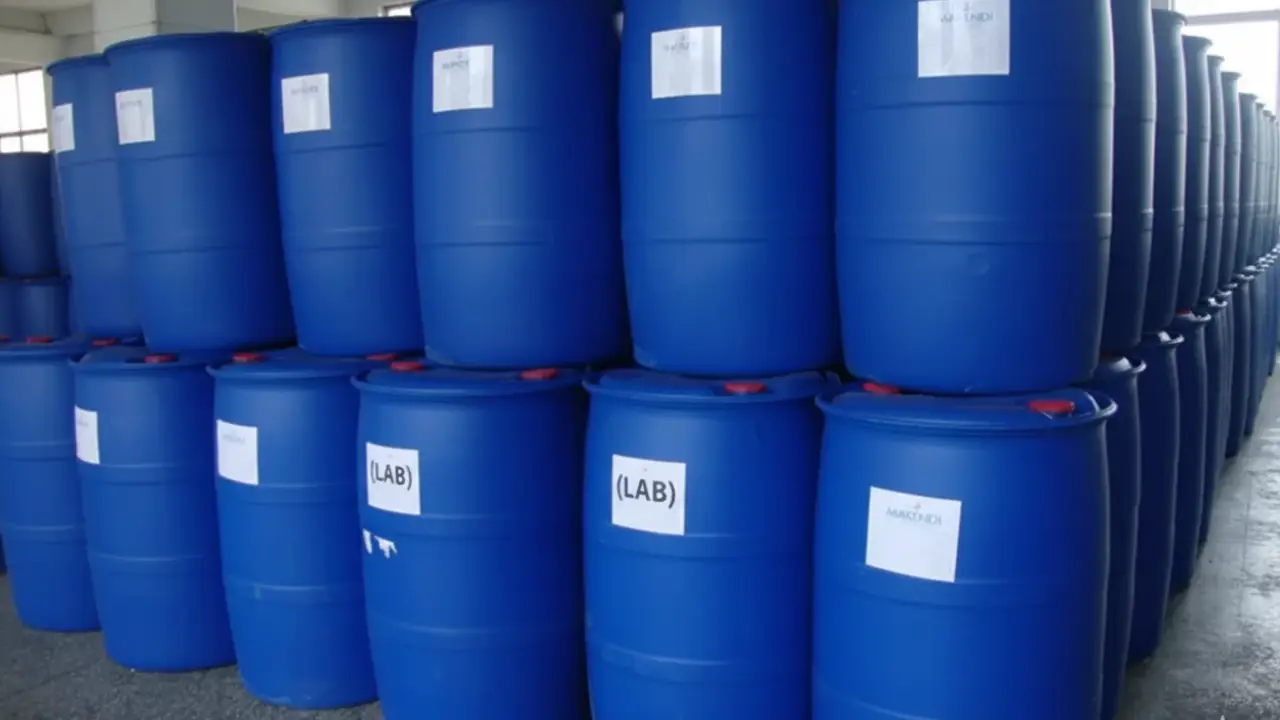Supplier of Linear Alkylbenzene-LAB From Turkey and Dubai-UAE

Linear Alkylbenzene (LAB) Product Description
Linear Alkylbenzene (LAB) is a key raw material widely used in the production of biodegradable detergents and cleaning agents. With the molecular formula C₆H₅C₁₂H₂₅ (typical chain length C10–C13) and CAS number 68081-84-5, LAB is a clear, colorless to pale yellow liquid at room temperature.
LAB is produced by the alkylation of benzene with linear olefins, resulting in a high-purity product with consistent linearity. This linear structure ensures high biodegradability, making LAB a preferred choice for environmentally-friendly detergents and household cleaning products.
Physical and Chemical Properties of Linear Alkylbenzene
LAB possesses properties that make it ideal for detergent and industrial applications:
-
Appearance: Clear, colorless to pale yellow liquid
-
Odor: Mild aromatic
-
Density (20°C): 0.87–0.88 g/cm³
-
Boiling Point: 280–310°C
-
Freezing Point: < -20°C
-
Viscosity (20°C): 3.0–4.0 mPa·s
-
Solubility: Insoluble in water, soluble in organic solvents
-
Flash Point: >120°C (closed cup)
-
Chemical Stability: Stable under normal storage, avoid strong oxidizers
These properties make LAB suitable for linear alkylbenzene sulfonate (LAS) production, surfactants, and industrial chemical formulations.
Applications and Uses of Linear Alkylbenzene
LAB is a versatile chemical with a wide range of industrial applications. Detailed uses include:
Production of Linear Alkylbenzene Sulfonates (LABSA):
- LAB is the primary feedstock for LABSA, the main surfactant in laundry detergents, dishwashing liquids, and household cleaners. LAB is sulfonated with sulfuric acid to produce LABSA, which offers excellent foaming, grease removal, and high biodegradability, meeting environmental standards. For complementary industrial solvents, you can also explore our Diethylene Glycol (DEG) page.
Surfactants and Industrial Cleaners:
- LAB is used to produce industrial surfactants, degreasers, and emulsifiers for manufacturing and cleaning applications. These surfactants improve wetting, emulsification, and dispersion of oils and dirt in industrial cleaning processes. LAB-based surfactants are widely applied in metal cleaning, textile processing, and surface treatment industries. For related chemical intermediates, see Monoethanolamine (MEA).
Chemical Intermediates:
- LAB serves as a building block in organic synthesis, enabling the production of specialty chemicals, coatings, and chemical additives. Its chemical stability and linear structure make it ideal for reaction with sulfonating agents or other functional groups in industrial chemical processes. For complementary glycol applications, check our Triethylene Glycol (TEG) page.
Lubricant Additives:
- LAB can be used in formulating lubricants and oil additives, improving lubricity, stability, and performance under high temperatures. This application is important in automotive, industrial, and marine lubrication.
Textiles and Coatings:
- LAB is used in coating agents, textile softeners, and finishing chemicals, enhancing spreadability, surface wetting, and smoothness in fabrics and coatings.
Oilfield Chemicals:
- LAB is employed in drilling fluids and oilfield surfactants, where it enhances emulsification, foaming, and dispersing properties for efficient extraction and processing.
LAB’s high purity, linearity, and stability make it indispensable for high-quality detergent formulations and industrial applications.
Handling, Storage, and Transportation of Linear Alkylbenzene
Proper handling ensures safety and maintains LAB quality:
-
Handling Precautions: Use gloves, goggles, and protective clothing. Avoid contact with skin and eyes. Work in well-ventilated areas to prevent inhalation of vapors.
-
Storage Recommendations: Store in sealed, corrosion-resistant containers in cool, dry, and ventilated areas. Avoid exposure to strong oxidizers or extreme heat.
-
Transportation Protocols: LAB is generally non-hazardous, but should be transported in clean, sealed tanks or drums, secured against leaks and vibrations. Comply with local and international regulations for chemical transport.
These measures ensure product integrity, safety, and a consistent supply.
Packing Details and Container Loading for Linear Alkylbenzene
LAB can be supplied in various packaging suitable for global distribution:
-
Bulk Shipments: ISO tank containers or seagoing vessels carrying 20–23 tons per 20-foot container, ideal for industrial-scale detergent producers.
-
Intermediate Volumes: Road tankers or 1,000 L IBCs (20 units per 20-foot container, ~20 tons), suitable for mid-scale chemical manufacturers.
-
Smaller/Custom Solutions: 200–220 kg steel or HDPE drums (80–90 units per 20-foot container, ~17–19.8 tons), suitable for regional or trial deliveries.
Proper packaging ensures stability, compliance, and efficient logistics.
Technical Data Sheets
| PROPERTY | UNIT | TEST METHOD | SPECIFICATION |
|---|---|---|---|
| T.N.P | WT% | UOP 698 | 0.5 max |
| LAB 9 | WT% | UOP 698 | <1 |
| LAB 10 | WT% | UOP 698 | 15 max |
| LAB 11 | WT% | UOP 698 | 24-44 |
| LAB 12 | WT% | UOP 698 | 22-36 |
| LAB 13 | WT% | UOP 698 | 17-27 |
| LAB 14 | WT% | UOP 698 | <1 |
| TOTAL LAB | WT% | UOP 698 | 92 min |
| Non LAB | WT% | UOP 698 | <7 |
| LAB 14+ | WT% | UOP 698 | 0.5 max |
| HAB | WT% | UOP 698 | __ |
| A.M.W | — | UOP 698 | 238-244 |
| 2-PHENYL % | WT% | UOP 698 | 20 max |
| Br.INDEX | Mg/100g | ASTM D1492 | 10 max |
| WATER | Ppm | ASTM D6304 | 200 max |
| Refractive.index | — | ASTM D1218 | 1.4800-1.4900 |
| Density(15.6°C) | gr/cm3 | ASTM D4052 | 0.8550-0.870 |
| Tetraline | WT% | ECOSOL METHOD | 1 max |
| Dr Test | — | ASTM D484 | Negative |
| SULFONABILITY | % | UOP-429 | 98 min |
| COLOUR | SYB | ASTM D156 | 29 min |
| VISCOSITY(40 °C) | CP | ASTM D444 | <10 |

